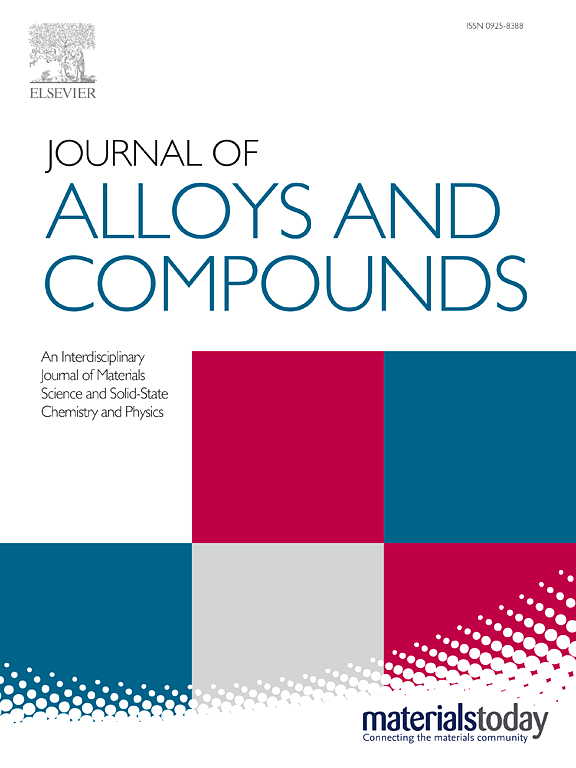Competition between superconductivity and ferromagnetism in 2D Janus MXH (M = Ti, Zr, Hf, X = S, Se, Te) monolayer
IF 5.8
2区 材料科学
Q2 CHEMISTRY, PHYSICAL
引用次数: 0
Abstract
Two-dimensional Janus transition-metal chalcogenide hydrides (2D-JTMCs) have generated a lot of interest as potential 2D superconductors, with numerous studies showing a transition from a metallic to a superconducting state at low temperature. They feature a three-layered structure consisting of a central transition metal layer, with chalcogen atoms below and hydrogen atoms above. The opening of a superconducting gap can stabilize a material when a metal has a high density of states at the Fermi level. Magnetic states also commonly result from a high density of states at the Fermi level in the unpolarized material (Stoner, 1938 [1]). In this study, we systematically investigate the instability of the normal state to superconductivity and ferromagnetism in two-dimensional hexagonal 2H and 1T Janus transition-metal chalcogenide hydrides (MXH), where and . In the normal metallic phase, Fermi surface instability leads to the formation of Cooper pairs, driving a superconducting phase transition characterized by a finite superconducting gap energy. We estimate the critical temperature () using the Allen–Dynes formula and compute the superconducting gap by solving the anisotropic Migdal–Eliashberg equations, predicting values in the range of 10–35 K. However, most JTMCs favor ferromagnetism over the normal metallic phase, with energy differences of 10–30 meV . Even after accounting for the superconducting gap energy, ferromagnetism remains energetically preferred. Using DFT with an on-site Coulomb interaction , we find that some JTMCs exhibit intrinsic half-metallic ferromagnetism. Our results suggest that a high electronic density of states in the normal metallic phase can drive the emergence of intrinsic half-metallic ferromagnetism, which is essential for spintronic and valleytronic applications.
二维Janus MXH (M=Ti, Zr, Hf,X=S, Se, Te)单层超导性与铁磁性的竞争
二维Janus过渡金属硫族氢化物(2D- jtmcs)作为潜在的二维超导体引起了很多人的兴趣,许多研究表明在低温下从金属状态过渡到超导状态。它们具有三层结构,由中心过渡金属层组成,下面是氢原子,上面是氢原子。当金属在费米能级上具有高密度态时,超导隙的打开可以使材料稳定下来。磁态通常也源于非极化材料[1]中费米能级的高密度态。在这项研究中,我们系统地研究了正常状态对超导性和铁磁性的不稳定性。二维六角形2H和1T Janus过渡金属硫系氢化物(MXH),其中M=Ti, Zr, HfM=Ti, Zr, Hf和X=S, Se, TeX=S, Se, Te。在正常金属相中,费米表面不稳定性导致库珀对的形成,驱动以有限超导隙能为特征的超导相变。我们使用Allen-Dynes公式估计临界温度(TcTc),并通过求解各向异性Migdal-Eliashberg方程计算超导间隙,预测TcTc值在10-35 K范围内。然而,大多数jtmc倾向于正常金属相的铁磁性,能量差在10-30 meV之间。即使在考虑了超导间隙能之后,铁磁性仍然是能量上的首选。利用具有库仑相互作用UU的DFT,我们发现一些jtmc具有本征半金属铁磁性。我们的研究结果表明,正常金属相中的高电子密度态可以驱动本征半金属铁磁性的出现,这对于自旋电子和谷电子的应用是必不可少的。
本文章由计算机程序翻译,如有差异,请以英文原文为准。
求助全文
约1分钟内获得全文
求助全文
来源期刊

Journal of Alloys and Compounds
工程技术-材料科学:综合
CiteScore
11.10
自引率
14.50%
发文量
5146
审稿时长
67 days
期刊介绍:
The Journal of Alloys and Compounds is intended to serve as an international medium for the publication of work on solid materials comprising compounds as well as alloys. Its great strength lies in the diversity of discipline which it encompasses, drawing together results from materials science, solid-state chemistry and physics.
 求助内容:
求助内容: 应助结果提醒方式:
应助结果提醒方式:


